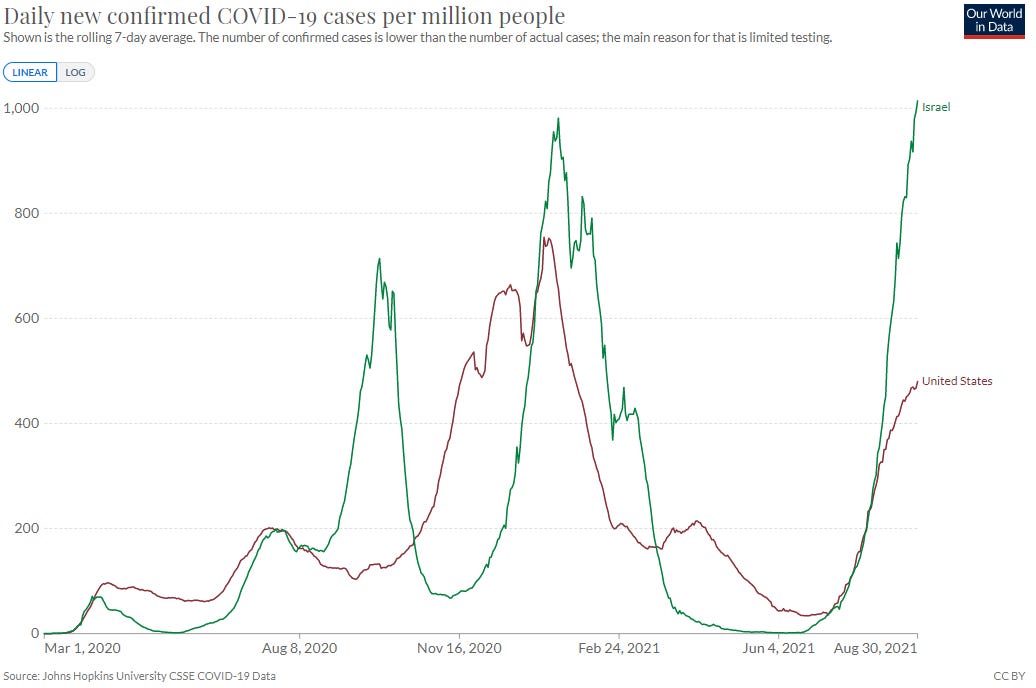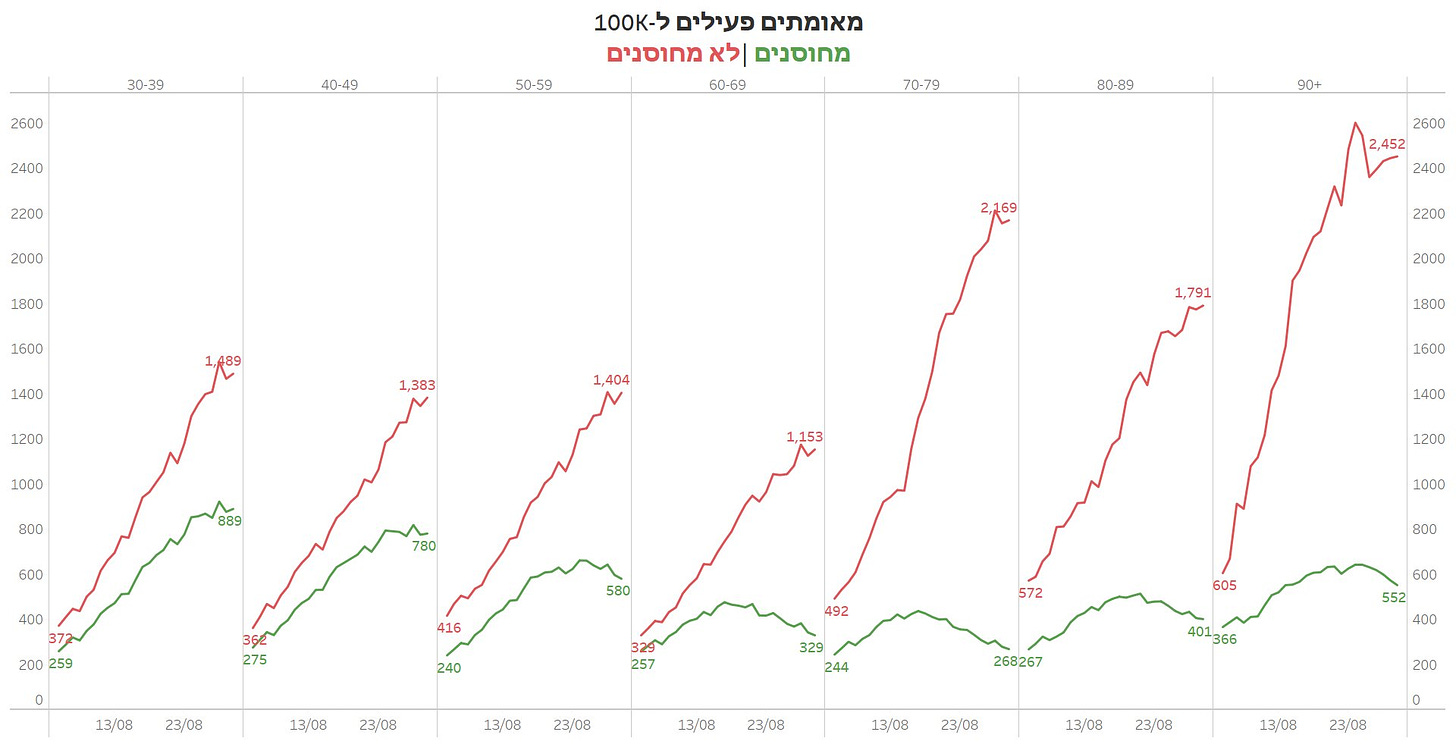In my post Monday, many noticed the high case rate in Israel. Israel now has one of the worst rates of COVID-19 per million in the entire world.
For those of you following along, this should be a surprise given that Israel was a global leader in vaccine administration. In fact, their vaccination rate today is one of the highest in the world: 75% of the eligible population.
So, why are they having a surge?
Like everything in this pandemic, there isn’t an easy answer. But, I’m going to try…
The timing of their vaccination campaign is important. Compared to other countries, Israel dominated vaccine administration right out the gate; they vaccinated 50% of their eligible population by March 2021. Exactly 6 months later, this case surge in Israel began. The 6-month mark is notable because many studies have shown waning immunity at around 6 months.
The timing is also important to note because it’s the same time that Delta was introduced. So, Israel had the perfect storm with waning immunity and the introduction of a highly transmissible and more severe variant.
Importantly, though, waning immunity is only for mild and moderate disease. Vaccines still protect against hospitalization and death. The Israel Health Ministry highlighted this in a July report (see figure below).
Unfortunately, even July data is out of date during a pandemic. In August, COVID-19 hospitalizations and ICU’s started increasing in Israel (but not at the rate of case growth). So, the real question was… are vaccines waning for severe disease too?
The Israel Health Ministry recently cleared this up. Last Thursday, they reported that the rate of serious disease (i.e. hospitalizations) among 60+ year olds that were unvaccinated (178.7 per 100,000) was 9x higher than serious disease among fully vaccinated. The rate of severe disease among unvaccinated <60 years (3.2 per 100,000) was 2x the rate than vaccinated. So, vaccines are still holding up for severe disease and death in Israel, which is fantastic.
The general population of Israel is young too. 28% of their population is under the age of 14 (as a comparison, 18% of the American population is <14 years). This means a large portion of their population is not eligible for the vaccine. When we take into account the total population of Israel (not just eligible population), only 62% of their total population is vaccinated. This leaves a lot of room for Delta cases.
So how do we fix this?
Pfizer’s data showed that antibodies in those ages ages 18 to 55 increase by 5x after getting a third dose of the vaccine. For people aged 65-85 years, they had 11x as many antibodies with the third dose. So, in Israel, a third dose was implemented in early August.
And, it looks like it’s helping a lot, especially among the older population. Yesterday, Gil Feldman shared a graph that showed Israel cases per 100K (y-axis) over time (x-axis). The graphs are split by age and vaccination status (red=unvaccinated; green=vaccinated). Two weeks after 3rd doses were implemented, cases started to beautifully diverge: cases among the vaccinated plateaued and cases among the unvaccinated continued to increase. We see the biggest difference for 60+ because they were first in line for a 3rd shot.
And we have even more updated data for those <60. On August 12, 15% of <60 year old’s received the third shot. The Raveh research lab at the Hebrew University of Jerusalem displayed a divergent pattern among them too.
United States debate
This has caused a lot of scientific debate in the United States as to whether (and when) we need a 3rd dose. If vaccines protect against hospitalization and death, are they really needed? Will vaccines eventually wane for severe disease? Do we need a 3rd shot for everyone or just the most vulnerable? Do we need it because of Delta or waning immunity or both? When is the best timing (5, 6, or 8 months)? In fact, this debate was briefly highlighted at an ACIP meeting on Monday (slides here). During that meeting, all that was concluded was that we need more data to make a decision. What the United States decides to do with a 3rd dose will be incredibly interesting to follow in the coming month.
Love, YLE












Another largely unvaccinated population that may be affecting Israel’s Covid rates, is the Palestinian workers that come into Israel proper daily from the West Bank. These workers and others living in the occupied territories have not had access to vaccine despite Israel’s responsibility to vaccine populations on land they occupy. This issue is largely ignored by the international public health community.
Is there a settled-on incidence rate (hopefully that's the right metric term) for Covid for people who are unvaccinated? I'm looking at the new Lancet ID article on breakthrough infections that gives a percentage of breakthroughs among vaccinated people, but I wondered if there's a settled similar percentage among unvaccinated people to use for comparison...or is that constantly fluctuating? I want to be prepared with that information if asked, and I can't find it anywhere. Thank you!
This is the study I referenced: https://www.thelancet.com/journals/laninf/article/PIIS1473-3099(21)00460-6/fulltext?fbclid=IwAR0YMupWCuLPXbe1oKP-C0vpnsVPQ2RoVDHaiHD8Vkgj3Z2j0zhUhwu6A-I